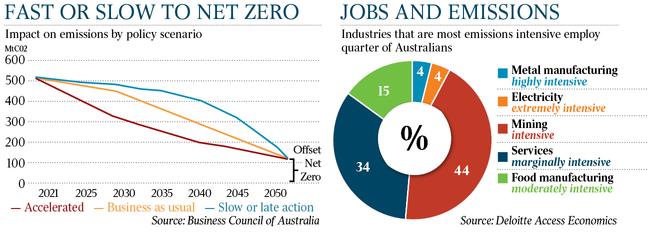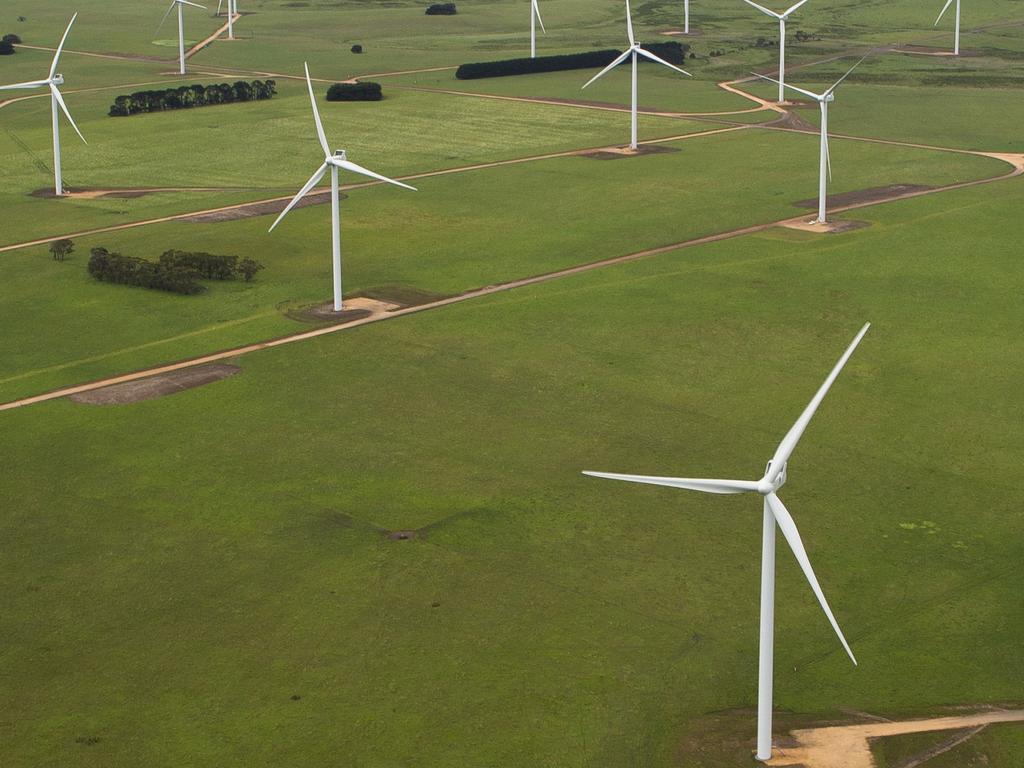Big emitters back in race toward net zero in BCA plan
Australia should almost double its 2030 emissions reduction target to between 46 and 50 per cent to achieve net zero by 2050, new BCA modelling reveals.

Australia should almost double its 2030 emissions reduction target to between 46 and 50 per cent to achieve net zero by 2050, with new modelling revealing the shift to a clean economy would boost GDP by $890bn and add 195,000 jobs over the next five decades.
The Business Council of Australia will on Saturday release a seven-point plan for the nation to reach net-zero emissions without crippling the regions, high-emitting industries and traditional export industries.
The BCA, representing some of the nation’s largest emitters, said a formal commitment to net zero by 2050 was needed to provide investment certainty and that 10-year federal carbon budgets would “provide predictability and a clear pathway to net zero”.
Other priorities include expanding the domestic carbon offsets market, providing access to international carbon offsets and establishing a national transition taskforce managing the shift to low-emissions industries in regional Australia.
Australia’s 2030 Paris commitment to reduce emissions by 26 to 28 per cent below 2005 levels by the end of the decade would need to be dramatically increased to bring forward action in high-polluting sectors and “put the country on track towards a permanently restructured economy by 2050”.
The new modelling, which includes economic and emissions forecasts, comes as Scott Morrison and Barnaby Joyce, along with their leadership teams, start formal negotiations next week to finalise a new climate package.
It is expected to feature improved medium- and long-term targets ahead of the UN climate change conference in Glasgow.
BCA chief executive Jennifer Westacott said the group wanted a 2030 emissions-reduction target of between 46-50 per cent.
“Setting a more ambitious interim target now will drive new investment and bring forward action in sectors such as electricity where we can deploy commercially viable technology at scale,” Ms Westacott said.
“Of course not all sectors will be in a position to decarbonise at the same pace, and our plan allows for this by accelerating early action in sectors where commercially viable technology exists today.”
Ms Westacott has previously defended the industry group’s description of Bill Shorten’s 45 per cent medium-term goal before the 2019 federal election as “economy wrecking”.
The BCA argues its criticism of Labor’s target, made months before the collapse of Malcolm Turnbull’s national energy guarantee, was based on the ALP’s failure to outline its plans and costings.
BCA president Tim Reed, a former MYOB chief executive, said corporate Australia would do “the heavy lifting in decarbonising our economy” and warned the fallout from doing nothing was grim.
“The momentum for change is overwhelming. If we leave climate change unchecked, the Deloitte Access Economics work tells us that the Australian economy will be $3.4tn worse off in net present value,” Mr Reed said.
“We will miss out on the opportunity to create new export industries, which we estimate to be valued at up to $30bn per annum by 2040.”
Mr Reed said the nation’s largest trading partners and global capital markets were accelerating transitions to net zero and it was time to “move forward (and) not engage in an endless debate about issues the nation and the world has moved past”.
Fourteen of Australia’s largest 20 largest trading partners, the BCA said, had committed to net zero emissions by mid-century and were shifting “demand away from carbon intensive imports”.

“This covers over 70 per cent of our two-way trade and 83 per cent of our exports. Our trading partners are also substantially increasing their 2030 ambitions, with the United States adopting a 50 to 52 per cent reduction on 2005 levels by 2030,” the Achieving a Net Zero Economy report said.
South Korea, a key trading partner, on Friday increased its 2030 target ahead of COP 26, announcing it would lift its 26.3 per cent goal to 40 per cent to achieve net zero by mid-century.
Amid internal pressure inside the Nationals partyroom over whether to back net zero emissions by 2050, Mr Reed said “the world is changing and Australia stands to profit enormously”.
The BCA, whose member companies include AGL, BlueScope, Qantas, Woodside, Rio Tinto, BHP, Origin and the big banks, said the Climate Change Authority should be expanded to lead a national response, co-ordinating the net-zero trajectories of all governments and taking responsibility for integrating climate policy.
With emissions in the National Electricity Market declining as new power generation and technologies emerge, Energy Minister Angus Taylor is leading the Energy Security Board’s post-2025 reforms to future-proof the NEM as coal-fired power stations exit.
The BCA and Deloitte modelling said if a smooth transition to net-zero emissions was achieved, on average Australians would be $5000 a year better off by 2050 “with regional Australians projected to be disproportionately better off than the national average”.
“The potential investment between now and 2030 to transform the electricity grid – leaving aside required investments in other sectors – could be in the order of $50bn for new renewable generation assets alone,” the research said. “The greater penetration of renewables in the grid will result in lower electricity prices for consumers while market reforms will ensure reliability and security of the system is maintained.”
One-in-four jobs are currently employed in the most emissions-intensive industries, increasing the urgency to decarbonise the electricity grid. The Morrison government has signalled that hydrogen and gas will play key roles in Australia’s future energy mix alongside solar, hydro, wind and batteries.
“Decarbonisation of virtually all other sectors in our economy is only possible if they have access to affordable, reliable and fully decarbonised electricity,” the report said.
The BCA plan recommends thresholds under the existing safeguard mechanism – requiring Australia’s largest greenhouse gas emitters to keep net emissions below a baseline limit – be expanded to capture more industries and companies.
Domestic carbon offsets would also be expanded to “balance abatement activity between the easy to abate and hard to abate sectors of our economy” and act as a revenue driver for regional communities.
“There is potential for an Australian export market for offsets, while access to credible international carbon offsets will be critical to achieving the net target,” the report said
The Future Fuels electric vehicle strategy, recently finalised by the federal government, will support the take-up of EVs as global car and truck manufacturers signal a rapid shift away from conventional vehicles.








To join the conversation, please log in. Don't have an account? Register
Join the conversation, you are commenting as Logout